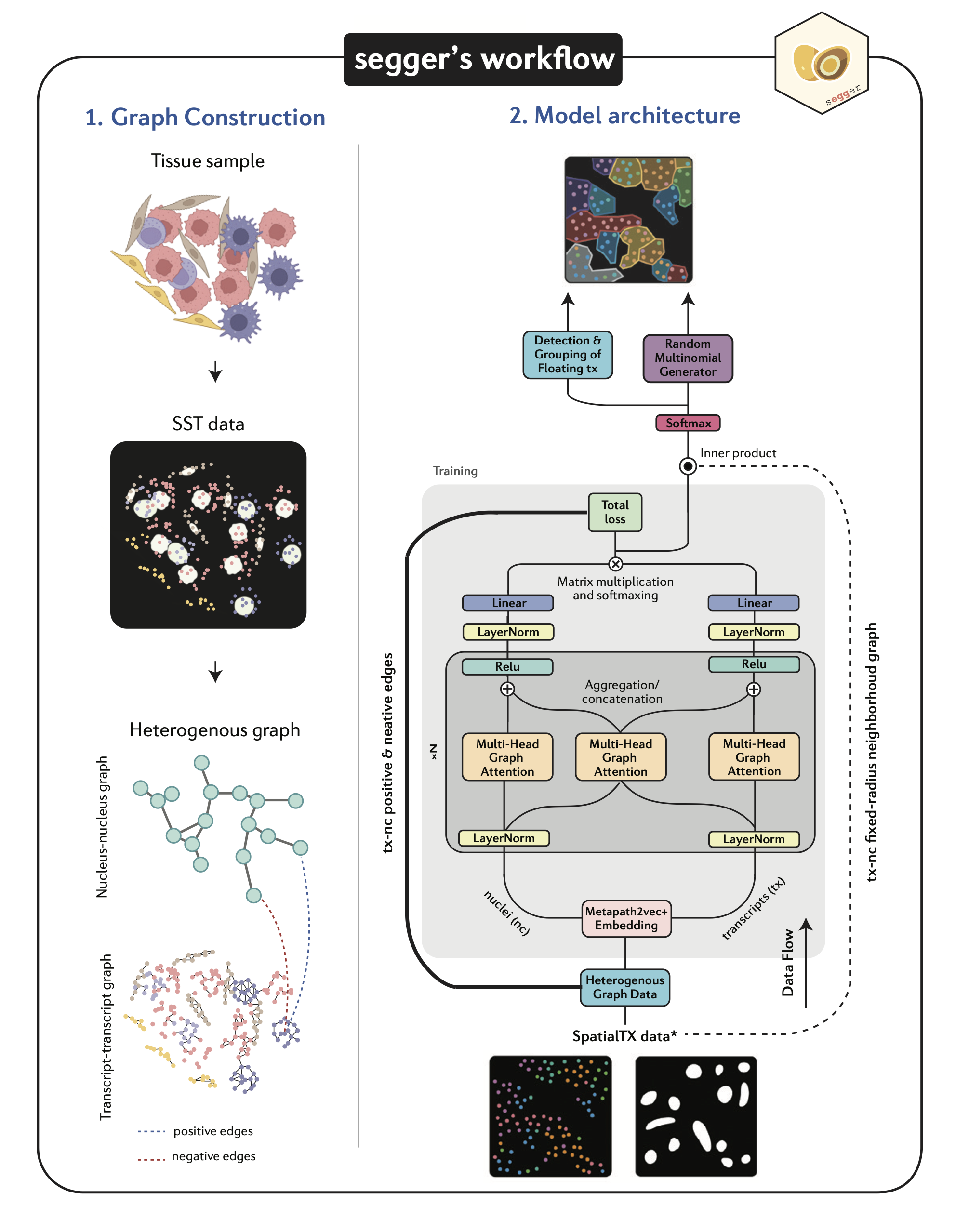segger is a cutting-edge tool for cell segmentation in single-molecule spatial omics datasets. By leveraging graph neural networks (GNNs) and heterogeneous graphs, segger offers unmatched accuracy and scalability.
-
💾 Installation Guide
Get started with installing segger on your machine. -
📖 User Guide
Learn how to use segger for cell segmentation tasks. -
💻 Command-Line Interface (CLI)
Explore the CLI options for working with segger. -
📚 API Reference
Dive into the detailed API documentation for advanced usage. -
📝 Sample Workflow
Check out our tutorial showcasing a sample workflow with segger.
- Highly parallelizable – Optimized for multi-GPU environments
- Fast and efficient – Trains in a fraction of the time compared to alternatives
- Transfer learning – Easily adaptable to new datasets and technologies
Spatial omics segmentation faces issues like:
- Over/Under-segmentation
- Transcript contamination
- Scalability limitations
segger tackles these with a graph-based approach, achieving superior segmentation accuracy.
Segger relies heavily on PyTorch Geometric for its graph-based operations. One must install its dependencies (such as torch-sparse and torch-scatter) based on their system’s specifications, especially the CUDA and PyTorch versions.
Please follow the official PyTorch Geometric Installation Guide to install the correct versions of torch-sparse, torch-scatter, and other relevant libraries.
Below is a quick guide for installing PyTorch Geometric dependencies for torch 2.4.0:
pip install pyg_lib torch_scatter torch_sparse torch_cluster torch_spline_conv -f https://data.pyg.org/whl/torch-2.4.0+cu121.htmlpip install pyg_lib torch_scatter torch_sparse torch_cluster torch_spline_conv -f https://data.pyg.org/whl/torch-2.4.0+cu118.htmlAfterwards choose the installation method that best suits your needs.
To set up Segger with micromamba and install the required dependencies, use the following commands:
micromamba create -n segger-rapids --channel-priority 1 \
-c rapidsai -c conda-forge -c nvidia -c pytorch -c pyg \
rapids=24.08 python=3.* 'cuda-version>=11.4,<=11.8' jupyterlab \
'pytorch=*=*cuda*' 'pyg=*=*cu118' pyg-lib pytorch-sparse
micromamba install -n segger-rapids --channel-priority 1 --file mamba_environment.yml
micromamba run -n segger-rapids pip install --no-deps ./For a straightforward local installation from GitHub, clone the repository and install the package using pip:
git clone https://github.com/EliHei2/segger_dev.git
cd segger_dev
pip install -e "."For installations requiring RAPIDS and CUDA 11 support, run:
pip install -e ".[rapids11]"For installations requiring RAPIDS and CUDA 12 support, run:
pip install -e ".[rapids12]"Segger provides an easy-to-use Docker container for those who prefer a containerized environment. To pull the latest Docker image:
docker pull danielunyi42/segger_dev:latestThe Docker image comes with all dependencies packaged, including RAPIDS. It currently supports only CUDA 12.2, and we will soon release a version that supports CUDA 11.8.
For users who prefer Singularity, you can pull the Docker image as follows:
singularity pull docker://danielunyi42/segger_dev:latest- PyTorch Lightning & PyTorch Geometric: Enables fast, efficient graph neural network (GNN) implementation for heterogeneous graphs.
- Dask: Scalable parallel processing and distributed task scheduling, ideal for handling large transcriptomic datasets.
- Shapely & Geopandas: Utilized for spatial operations such as polygon creation, scaling, and spatial relationship computations.
- RAPIDS: Provides GPU-accelerated computation for tasks like k-nearest neighbors (KNN) graph construction.
- AnnData & Scanpy: Efficient processing for single-cell datasets.
- SciPy: Facilitates spatial graph construction, including distance metrics and convex hull calculations for transcript clustering.
segger is open-source and welcomes contributions. Join us in advancing spatial omics segmentation!
-
Source Code
GitHub -
Bug Tracker
Report Issues -
Full Documentation
API Reference
